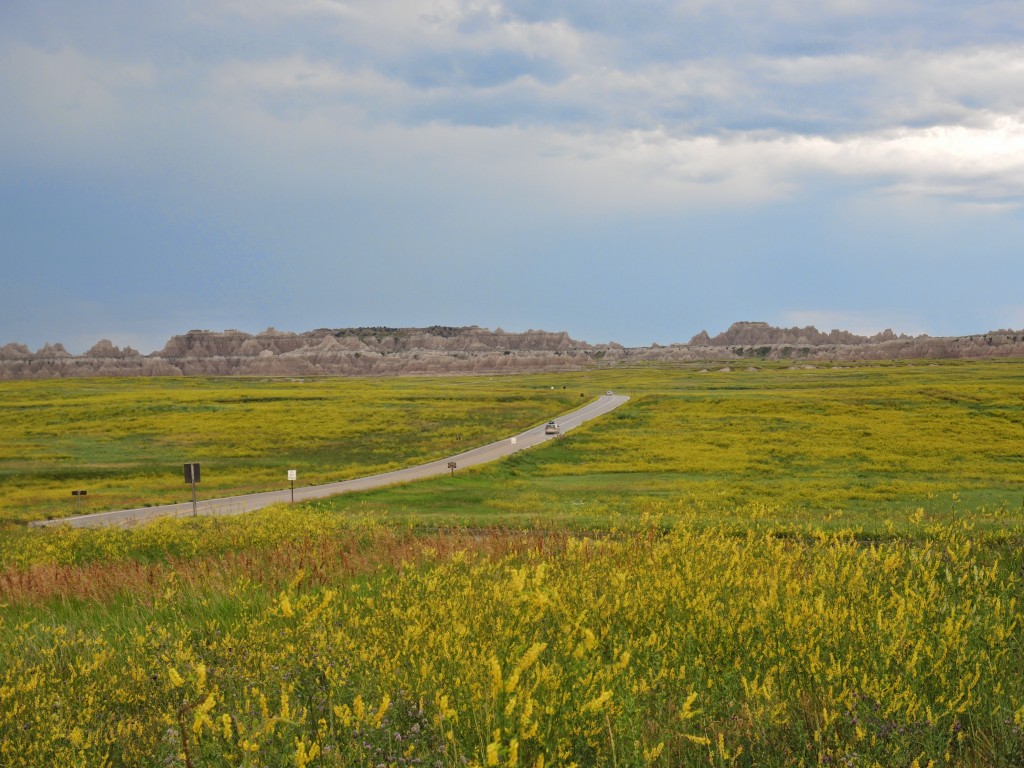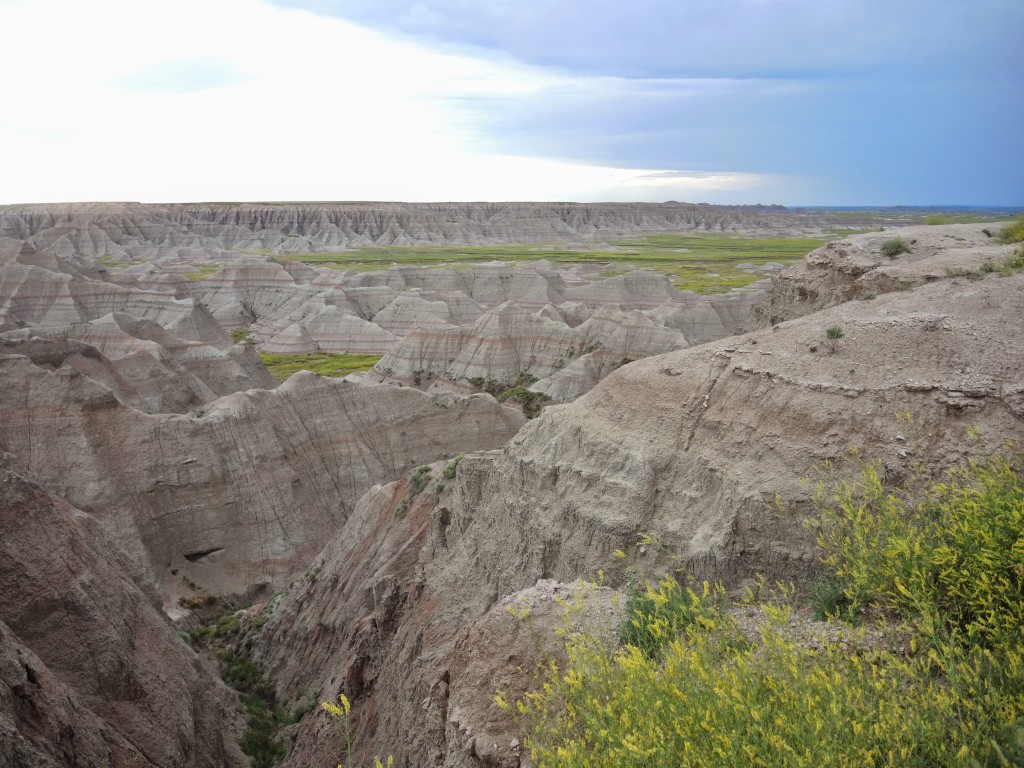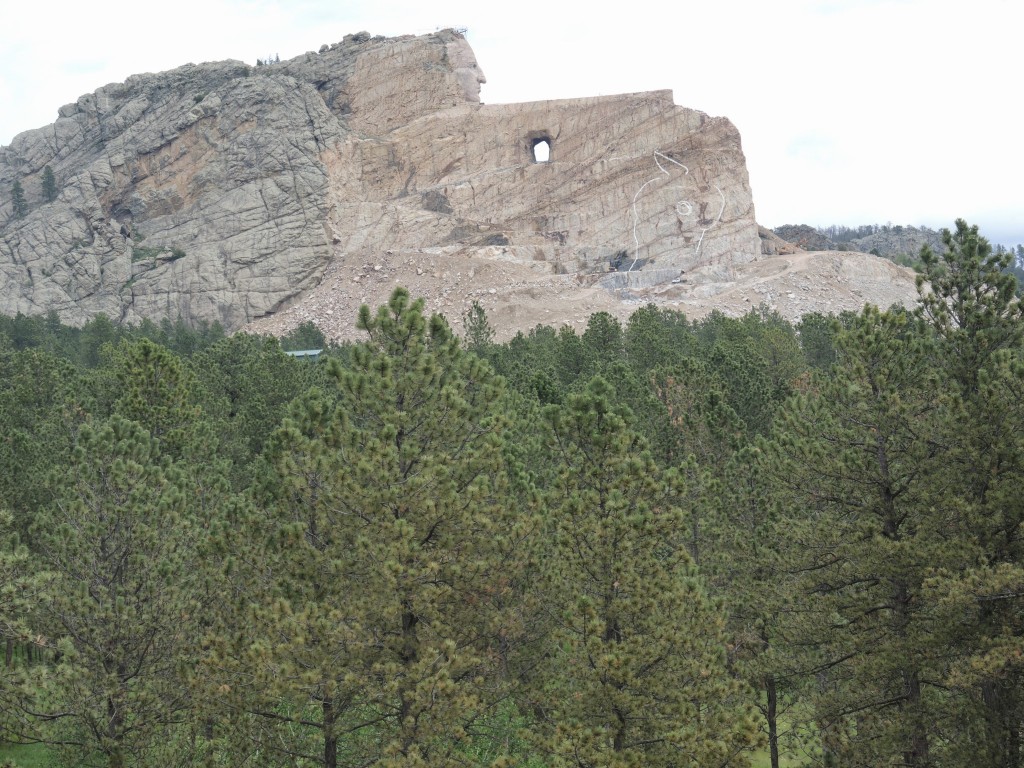I expected Monday would be one of the more ambitious days of the trip and it proved to be just that. I started a bit later than I’d planned because I miscalculated the impact of the time change when I’d cross from central time to mountain time. Nevertheless, the drive to my first unplanned destination, the Badlands, was about half an hour.
I call the Badlands an unplanned destination because although I expected to pass through them, I didn’t really budget time to do it thus making my trip through them rather cursory. We Americans did not invent the term Badlands for this place in South Dakota. French explorers called the area “les mauvaises terres a traverser.” Before the French arrived, the Lakota called the place “mako sica.” Both translate as “bad lands.”
The Badlands have an otherworldly feel to them. It’s a compressed area of wide wildflower filled prairies, peaks, gullies, and buttes of rock and mud that change color depending on the light and the angle at which you view them. I fear my camera doesn’t quite catch the intensity of the colors of the formations.
Still, imagine yourself a settler, a pioneer or an explorer. You’re crossing the prairie and in the distance you see this:
Then you reach these formations and you have to cross this:
And just when you think you’re out of them and you’re back on the prairie, they rise up again. And again. (Minutes before I took the first of these two pictures, the sky was ablaze with lightning.)
Two common geologic forces – deposition and erosion – created the Badlands. The process of deposition, in which the movement of shallow inland seas (mainly the Western Interior Seaway that I wrote a little about here and here update from 2023), rivers, volcanoes, and wind gradually stacked one layer of rocks on top of another. In the Badlands, the process began about 75 million years ago (mya) with the deposition of the Pierre Shale and ended nearly 28 mya when the Sharps Formation became the top unit of Badlands stratigraphy.
The formation was generally stable until about 500,000 years ago when the Cheyenne and White Rivers began carving their way through the landscape rapidly eroding the rocks in the process. Of course, rapid is a relative term. The erosion rate in the Badlands is about one inch per year. This seems almost incomprehensibly slow until you consider that the nearby Black Hills need nearly 10,000 years to experience that single inch of erosion.
Because the layering process required nearly 50 million years and arose from different sources, their composition includes at least seven major types of rock. These are sandstones, siltstones, mudstones, claystones, limestones, volcanic ash, and shale.
Most of the volcanic ash came from eruptions in the Great Basin that spans nearly all of Nevada, most of Utah, eastern portions of California and Oregon, and western segments of Idaho and Wyoming. Many of the rock layers in the Badlands are closer to a blend of equal parts ash and eroded sediment. The only layer of pure volcanic ash is called the Rockyford Ash that forms the base of the Sharps Formation.
Other strata identified between the Pierre Shale and the Sharps formation are, in order, the Yellow Mounds, the Chadron Formation, and the Brule Formation.
You can see more of this park if you want.
The exit to the loop road I took through the Badlands left me just a few miles from the town of Wall. Of course, I had to make the obligatory stop at Wall Drug, the place Roadside America calls, “the American roadside wonder best known to people who’ve never been to America.” Frankly, I was singularly unimpressed. It’s more the Wall Mall than an oversize CVS. But I was able to use the restroom and take four pictures.
From Wall, it was on to the Crazy Horse Memorial. Those among you who are familiar with my other travel journals know that I typically add educational elements. With that said, it’s time for a bit of history.
Gutzon Borglum started his work on Mt, Rushmore in 1927 – more on this later in the next entry – and one of the people working for him in the design stage – perhaps around 1924 – was a man named Korczak Ziolkowski who was also a sculptor. Ziolkowski had some sort of a falling out with Borglun and left the project. He had, apparently, learned a bit about Borglum’s blasting techniques.
In 1939, Henry Standing Bear, a Lakota leader approached Ziolkowski with the idea of creating a monument for a Native American hero. It’s said that Ziolkowski wanted to place the monument in the Tetons but Standing Bear insisted it be in the Black Hills because they are sacred to the Lakota. Ziolkowski’s ultimate vision encompassed much more than the mountain carving. It included a medical training center and the Indian Museum of North America among other projects. Because he feared government interference, the effort has eschewed any government funding. The consequence of this has been painfully slow progress.
Blasting began in 1948 and the mountain looked like this the day of my visit:
When Ziolkowski died in 1982, he was working largely on what would be the arm and the horse’s head. His wife and several of his children took over the work and she focused on completing the head which, at 87 feet high, is nearly half again as tall as the 60-foot-tall men on Mt. Rushmore. It’s being carved three dimensionally and when completed, it will be 641 feet long and 563 feet high and will look like this:
The family matriarch died earlier this year but the family continues the work.
Although I couldn’t find it mentioned at the visitor’s center, the memorial is not without controversy. The two main issues are first, its placement in the Black Hills. Since these are sacred to the Sioux, in the view of some, they should have remained undisturbed. The second controversy arises from having Crazy Horse point his finger. This is meant to symbolize his statement, “My lands are where my dead lie buried.” Most Native American cultures don’t use their index fingers to point. They consider it rude at best and taboo at worst. A scout would point with his thumb.
Poor planning and a later than expected start struck again and sadly, I didn’t take the bus ride that brings you closer to the mountain so my photos aren’t as dramatic as they might be. I felt I couldn’t afford the time as I still had Mt. Rushmore to visit and then had to drive nearly the entire width and half the height of South Dakota before day’s end.
Note: In keeping with my 2022-2023 reformation of the blog into shorter entries, backdated to maintain their sequence, any comments on this post might pertain to its new configuration. See the explanation in the post Conventions and Conversions.




I have to agree re Wall Drug. One of those attractions that are highly touted in travel information articles that turn out to be less than thrilling once one makes the trek. I was there and I have the pictures to prove it. I must also say that it does not appear that much progress has been made on Crazy Horse since we visited several years ago. This will not be completed in my lifetime, I do not believe. A noble undertaking, but one that may prove futile in the long run. Too bad.
I agree. Progress on the Crazy Horse Memorial seems to be excruciatingly slow. On the other had, the effort is massive.
Todd, I just became aware of the Crazy Horse memorial when I saw “Stephen Fry in America” a BBC production.
I very much appreciate your observations about the courage of early pioneers as they confronted unknown territory in the US. Remember, the Donner Party was snowed in because they missed crossing the Rockies by ONE DAY.
I cannot imaging how it would be to confront the vast amount of spaces in the mid-west and western US without maps, without communication methods, without knowledge of where to find water or food. Daunting to say the least.
Thanks for the pics of the “badlands” Wait til you experience the BIG SKY of Wyoming/Montana. Much the same experience as the Great Plains but with the increased elevation the clouds seem to almost be within touching range. I hope you allow some time to just contemplate the vast array of it all. Be Safe
Sadly, Wyoming / Montana and their Big Sky are a trip for another season. I’m now headed south along Ol’ Man River.
I went to Wall Drugs 39 years ago. I thought it was the badland’s equivalent of South of the Border on I-95. More about the signs telling you about it than the place itself.
And it is, indeed, the signs that help spread its fame.
Todd
Having been to the East Coast, Florida, Texas and all over California, I thought Middle America had little to offer. How wrong I am. Text and pictures great. I read Robert Pirsig’s Motorcycle Maintenance years ago. I think himself and his son did something similar? Perhaps I am wrong on the location, but to this day it remains the best book I have ever read.
Keep it up.
John
Thanks, John. So good to hear from you. I hope you and Sally are doing well and I expect the garden is breathtaking!
Spent a few days in the Black Hills a few years ago and was totally impressed. A lot of that part of the country is flat, but the Black Hills were awesome. Wife and I went to Rushmore and Crazy Horse. While at Crazy Horse, they blasted and I got some pictures that were cool, but agree that progress is slow.
Anyone going that way that has time should try the 1880 Train out of Keystone. It was fun and worth the time commitment.
I would have liked to do that together with some other activities but the Mt. Rushmore idea came at the last minute and I tacked it on to the main part of the trip. I may do a northern trip sometime in the future.
We took this exact trip last summer, Todd. Your photo of Rushmore is stunning! I never heard about the trail that takes you to a closer vantage point. Was it an arduous hike? Amazing, and kicking myself that we missed it!
While at the Badlands, I heard about the free “Night Sky Program,” and ended up staying an extra day because clouds cancelled the viewing on our first night. (I’m a science nerd.)
Sadly, I agree with some of some of your readers on the Crazy Horse memorial’s prospects for completion. Perhaps the project will find a generous benefactor in the not-too-distant future. We are thoroughly enjoying your travel journals!
Here’s my Badland’s review. http://www.tripadvisor.com/ShowUserReviews-g143012-d145582-r170635307-Ben_Reifel_Visitor_Center-Badlands_National_Park_South_Dakota.html
That sounds like it would have been really interesting and fun!
“This is meant to symbolize his statement, “My lands are where my dead lie buried.” Most Native American cultures don’t use their index fingers to point”
I disagree
Sincerely, Minta